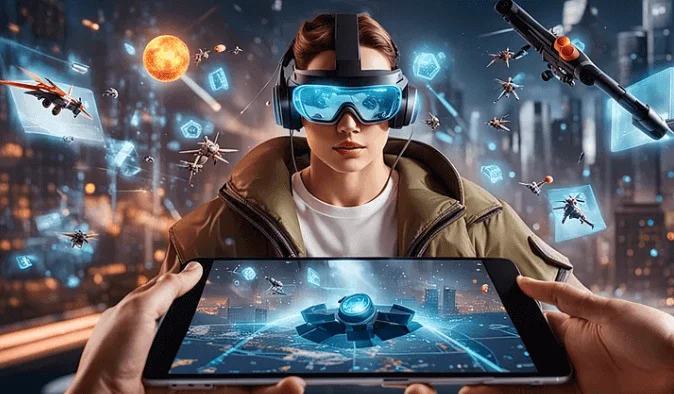Introduction:
The metaverse, a virtual shared space that many tech enthusiasts and futurists have been fascinated with, has been a source of inspiration for decades. Virtual Reality (VR) and Augmented Reality (AR) technology have made these ideas for a fully immersive digital universe a real possibility. This paper is an in-depth look into how virtual reality (VR) and augmented reality (AR) are set to revolutionize the metaverse.
Understanding VR And AR:

Before indulging ourselves into the possible role of these devices on the metaverse, be first aware that differentiate virtual reality from augmented reality. VR puts a user into a realistic situation that is 100% artificial and gives self-induced perception of the reality through using specific tools like a headset. However, augmented reality (AR) enhances reality by overlaying digital elements onto the real world. This technology transforms our physical surroundings using devices like smartphones or smart glasses. AR virtualizes our environment, blending the digital and physical seamlessly.
Enhanced Immersion And Presence:
One of VR advantage in the metaverse that it offer is its capability to take the user to a place beyond the earth`s sphere. The new virtual reality headsets offer users a gateway into the actual virtuality, including 3D environments, which they can perceive like they were there in the flesh and could have interacted with the objects and other people on them. An entertaining metaverse should involve the user in the heart of the events. Therefore, the feeling of joining the virtual world frequently should strongly be stimulated.
Expanding Social Interactions:
AR that help place digital content which are related to the real world and have the ability to improve the social interactions in terms of the metaverse. Imagine yourself strolling along the sidewalk and seeing virtual avatars of your friends and colleagues who can see you.Visualize yourself attending virtual meetings and conferences that become integrated into the physical environment around you. Embrace the blending of the virtual and physical realms as you navigate this immersive digital landscape. The convergence of digital and physical realms could blur, making it hard to differentiate between them. This fusion may foster richer social connections and interactions within the metaverse. Ultimately, this integration could enhance inclusivity and depth in virtual social experiences.
Spatial Computing And Environment Creation:
The VR and the AR technologies equally allow you to see the room in its three-dimensional space and interact with the 3D objects there. This means users may build, alter, and navigate information in virtual environments at the same time to the level of complete independence and creativity’s freedom as the metaverse in the context of a virtual world. Spatial computing not only allows for the designing of virtual buildings but also the shaping of digital sites. Metaverse users can then create their own version of the world they would like to live in. Which is not only limited to what they have in mind but to the worlds as well.
Commerce And Entertainment:
VR and AR integration into the metaverse have both fundamental and complex impacts concerning businesses and the industry of gaming. The virtual storefronts and the immersive shopping experiences can of course turn e-commerce upside down, and change both the purchasing process and the state of mind of users by offering them to go shopping in 100% interactive virtual environments. Also in this sense, the VR-based open-air museums, from cinema teh worlds of make-believe to game playing in AR, are the sources of entertainment on the metaverse.
Also read: Non-Fungible Tokens: How Are Nfts Revolutionizing The Gaming Industry
Challenges And Considerations:
On the one hand, a lot of opportunities are seen in the metaverse with regards to the use of virtual reality and mixed reality, but, on the other hand, some challenges and considerations must be considered. These problematic issues like privacy and data safety are among others. Fairness in acquiring access to digital culture is another important concern. Safeguarding against the possibility of addiction and high reliance on the digital surroundings is also a crucial consideration. Besides that, technical illeagles like latency and hardware limitation will impede the growing and applicability of the VR and AR in the metaverse as well.
Conclusion:
The integration of Virtual Reality (VR) and Augmented Reality (AR) technologies into the metaverse promises to revolutionize digital interactions and experiences. VR transports users to immersive artificial worlds, while AR enriches reality with digital elements, expanding social interactions and enabling creative expression. The convergence boosts commerce and entertainment in the metaverse. However, privacy issues and technical constraints pose challenges. Addressing these is crucial for a responsible and sustainable evolution of the metaverse.
In my personal experience, I have seen the transformative power of VR and AR. These technologies have enhanced gaming, virtual meetings, and collaborative workspaces. They offer immersive experiences that can revolutionize how we interact and work. While there are undoubtedly hurdles to overcome, the promise of a fully realized metaverse driven by these technologies is both exciting and inspiring. As we integrate VR and AR into our digital lives, it’s crucial to consider ethical, social, and technical factors. Building a metaverse requires a focus on inclusivity, engagement, and sustainability. By prioritizing these aspects, we can create a metaverse that benefits everyone.

